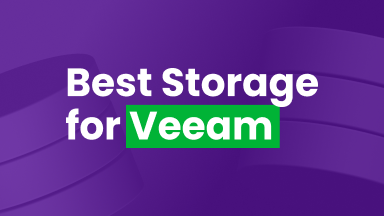File storage: what is it?
Storage is as necessary to technology as the human brain is to our bodies. The fact that you are reading this blog on our website tells me you already understand just how vital storage can be for business infrastructure. Whether it’s a primary, secondary, archive, or replicated, storage is a foundational building block in which all operations intertwine. The complication often comes from deciding what storage to buy and for what use case. Solving for these specifics is why we deliver our unique take on object storage at Object First, but we will get to that later!
Given its tremendous importance, we thought, why not do a level set on storage? Over the following three blogs, we will reevaluate the foundational knowledge of the most known storage formats admins use today: file, block, and object.

Each has advantages and disadvantages that can attract users with varying use-cases and performance. So, take a swig of coffee, sit back in your chair, and refamiliarize yourself with some sweet storage technologies.
Part 1. What is File Storage?
As you already know, file storage technology uses a hierarchical method to organize and store information on a hard drive or a NAS device. You can store data in files, arrange them in folders, and then manage the latter with directories and subdirectories. If you are using file storage, the typical file location process goes from directory to subdirectory, from subdirectory to folder, and from folder to file.
This approach to organizing data is simultaneously an advantage and a disadvantage. Admittedly, such a method is straightforward for organizing and structuring data, making it widespread. On the other hand, managing it efficiently becomes more difficult as the database grows. Folders, directories, and subdirectories are mounted upon each other until the system becomes bogged down. At some point, it becomes impossible to deal with both in terms of time and usability.
Pros & Cons of File Storage
File storage is excellent if you need a centralized, easy-to-access, affordable way to store files. However, it is not without downsides. Let’s talk pros and cons.
Pros:
- Easy & Familiar: What makes file storage so famous and recognizable is that this is usually the storage option for end users. Most can use it without expertise exceeding basic computer skills, making file storage the most familiar and straightforward storage format for most users. Such a storage system is intuitively self-explanatory because all you need to do is name a file and organize it according to a straightforward hierarchical model. You don’t need to write apps or code to access your data.
- Standard Protocols: To operate, the file storage technology applies standard file-level protocols such as Network File System (NFS), Common Internet File System (CIFS), or Server Message Block (SMB). The average user usually operates in a Windows or Linux OS. Thanks to protocols like SMB/CIFS and NFS, it is possible to read files and write them over LAN to a Windows or Linux-based server easily.
- User-level management: It’s hard to stress enough just how user-friendly file storage is for an average customer. Users can manage, create, and delete their files however they choose. You can set a file as write, read-only, or locked (specific users cannot access the file even as read-only). That way, a user can decide whether the users can make changes in files, view them, or even not be able to access data at all. Moreover, you can also manage access by setting up password protection and encryption for files for greater security.
Cons:
- Difficulty in Accessing Data: Hierarchical storage is a blessing and a curse: while it works great for separate users who don’t manage massive amounts of data, accessing and managing data within a file storage array becomes a major inconvenience as the volume grows. The more files, folders, and directories there are, the more time you will spend finding and accessing a piece of the required information. If we are talking about business organizations, sooner or later, managing file storage becomes a significant waste of time.
- Unstructured Data: Although storing some unstructured data within a file storage environment is technically possible, it is generally not considered the best solution for large volumes.
- Affordability: File storage has numerous benefits that make it popular among users. It is convenient, easy to operate, and relatively fast. However, the only way file storage scales out is by buying new storage systems, which can get expensive as a business grows.
File Storage Use Cases
The most familiar, popular, and recognizable storage format ever, file storage remains a genuinely efficient solution for numerous data needs. Here are some:
- Local Files: Nothing beats file storage on a small scale. In many cases, all that is needed is locating, managing, sharing, and accessing files spread across a limited environment. Whether an office team or any small organization, file storage remains simple, efficient, and easy to use. It’s a fantastic choice for the majority of end users.
- Documentation Collaboration: File sharing document collaboration is necessary for group work since it requires making changes and comments in real-time. Online file sharing also helps you keep files and comments in one organized unit, leaving tiresome grinding through endless emails and folders in the past. All you need to do is upload, store, and share files across one centralized library. The location doesn’t matter because in every scenario, be it cloud or on-site, it makes it possible to collaborate on files with internal and external users or guests outside the network.
Can we file this one away in a folder? (The jokes won’t get any better moving forward.) File storage is the most accessible and widespread format, and there is no question why. Are you curious to find out how it compares to block storage? Be sure to check back next week to learn all about it.



